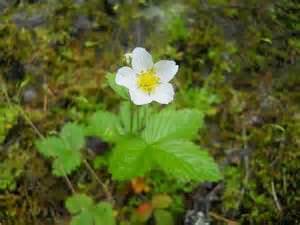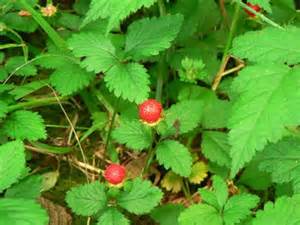 The bloom of strawberries is a sure sign that summer is just around the corner. The Pacific Northwest is fortunate to have three delectable varieties of wild strawberry.
The bloom of strawberries is a sure sign that summer is just around the corner. The Pacific Northwest is fortunate to have three delectable varieties of wild strawberry.
Beach strawberries (Fragaria chiloensis) can be found along the upper edges of beaches on Washington and Oregon coasts. The leaves are thick and leathery compared to those of other wild strawberries of the Pacific Northwest.
The other two strawberries in the region are usually found from the interior valleys west of the Cascades to alpine areas throughout the region. Wild, or Blue-leaved strawberry (Fragaria virginiana) and Wood strawberry (Fragaria vesca) are very similar in their leaves, flowers and fruit. They are found growing along the edges of clearing in woods, and often on rocky, warm south-facing slopes. The bright red fruit of our wild strawberries is quite delicious and very similar in appearance to domestic strawberries except for size, but the flavors of the native strawberries are quite different and special. The berries are found in greatest quantities May-June, depending on location.
 Identification: Strawberries have five white petals, five sepals and many stamens, similar to other members of the rose family. The basal leaves are divided into three leaflets.
Identification: Strawberries have five white petals, five sepals and many stamens, similar to other members of the rose family. The basal leaves are divided into three leaflets.
The juicy, edible part of the strawberry is not truly a berry. The true fruits are actually the tiny, brown achenes spaced evenly over the surface; each one has a dry fruit wall topped by a style and stigma where pollination takes place. A little brown seed is found inside. These are located on and surrounded by the enlarged fleshy, sweet receptacle portion of the stem—the “berry” that we love so much.
Propagation is easiest by removing the plantlets (daughter plants) that form along the stolon’s (runners) before the last spring frost and after the first frost of the fall. You can also place a small flower pot with potting soil in the ground under a plantlet. As it grows it will establish rots in the pot. Then in the dormant season you can cut the stolon from the main plant and move the potted plant to the home nursery for a year.
Strawberries can be grown from seed. The best way is to remove the seeds from the fleshy receptacle is to chop up the strawberries in a blender and dry the flesh and seed mix. Spread the dried mixture over a garden potting flat that has been filled with potting soil. This should be done in the fall and left outside to stratify over the winter. Germination occurs after the weather warms in the spring. After they have fully developed new leaves they can be separated into individual pots for the summer and planted in the fall or next spring.
When to harvest – early May to late September
 Finding strawberries to harvest requires getting down near the plants. The leaves are thick and abundant. They hide the fresh red berries from predator’s eyes. So you will need to move the foliage back to see if there is any fruit and if it is ready to eat.
Finding strawberries to harvest requires getting down near the plants. The leaves are thick and abundant. They hide the fresh red berries from predator’s eyes. So you will need to move the foliage back to see if there is any fruit and if it is ready to eat.
Use and care of berries
The best way to use the wild berries is out of hand (pick them and eat them). The next best way is as part of fresh salad or garnish. In my opinion they are too good to be hidden in heavy sugar products (jams, jellies, syrups). I must concede they do make a fantastic homemade ice cream or yogurt.
They will not last over 24 hours after picking if you don’t cool them. Bring along a cooler and ice pack if you are going to harvest large amounts to take back to your home. If you want to freeze them in the field, a small piece of dry ice will do the trick. Place the dry ice in the cooler with the berries on foil so that they will not touch the dry ice.
Dried strawberry leaves are used in simple teas, and medicinals have been obtained from the leaves and stems. Strawberries are members of the rose family and their herbal use is similar to other members like raspberries, Potentilla and rose.
As you walk your properties stop and check the strawberries. When you find they are ripe plan a family outing. They are fantastic addition to a picnic basket.
A few of the books that inspired this article include:
“Huckleberry Country Wild Food Plants of the Pacific Northwest” by Mary and Steven Thompson, Wilderness Press (Birmingham, Ala.) 1977.
“Northwest Foraging: The Classic Guide to Edible Plants of the Pacific Northwest” by Doug Benoliel, Mountaineers Books (Seattle) Rev. Upd. edition 2011.
“Medicinal Plants of the Pacific West” by Michael Moore, Museum of New Mexico Press (Santa Fe) 2011.
“Encyclopedia of Northwest Native Plants for Gardens and Landscapes” by Kathleen A. Robson, Alice Richter, and Marianne Filbert; Timber Press(Portland, OR).
By Jim Freed, WSU Extension Forest Products Specialist
freedj@wsu.edu
